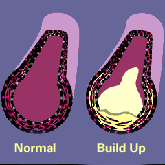What's So Bad About Cholesterol?
 Cholesterol has a worse reputation than it deserves. This waxy lipid (a kind of fat) is essential to good health. It builds the membranes that hold cells together. It's used in making certain hormones and the digestive fluid, bile. It's also part of the protective covering that wraps nerve fibers. In blood, the cholesterol molecule does not dissolve in plasma. It circulates attached to water-soluble compounds called lipoproteins. High-density lipoproteins, HDLs, are the so-called 'good' carriers. They carry cholesterol away from artery walls. They take it to the liver for disposal. They also prevent free radicals from combining with oxygen and damaging artery walls.
Cholesterol has a worse reputation than it deserves. This waxy lipid (a kind of fat) is essential to good health. It builds the membranes that hold cells together. It's used in making certain hormones and the digestive fluid, bile. It's also part of the protective covering that wraps nerve fibers. In blood, the cholesterol molecule does not dissolve in plasma. It circulates attached to water-soluble compounds called lipoproteins. High-density lipoproteins, HDLs, are the so-called 'good' carriers. They carry cholesterol away from artery walls. They take it to the liver for disposal. They also prevent free radicals from combining with oxygen and damaging artery walls.
Cholesterol is only bad when it forms plaques that block arteries and impede blood flow. LDLs, for low-density lipoproteins, are the 'bad' carriers. They let cholesterol attach to artery walls. If it combines with oxygen there, it attracts white blood cells to the site. The body treats a build-up of oxidized LDL-cholesterol as an injury. The area becomes inflamed, then heals, only to become inflamed and heal again. That sets the stage for a blood clot or heart attack.
When doctors measure cholesterol levels, they look at the total amount of cholesterol in the blood, but they also compare HDLs and LDLs. For example, a low risk is less than 200 milligrams per deciliter of cholesterol and less than 130 milligrams of LDL (bad cholesterol). A moderate risk is 200-239 milligrams of cholesterol and 130-159 milligrams of LDL. A high risk is more than 240 milligrams of cholesterol and more than 160 milligrams of LDL.
About the Author
Faith Brynie, Ph D
 Faith Brynie holds a B.A. in Biology from West Virginia University and an M.A. and Ph.D in science curriculum and instruction from the University of Colorado. She writes books and articles on science and health topics for children, teens, and non-scientist adults. Some of her books have won awards, including two 'Best Book of the Year' citations from the American Association for the Advancement of Science.
Faith Brynie holds a B.A. in Biology from West Virginia University and an M.A. and Ph.D in science curriculum and instruction from the University of Colorado. She writes books and articles on science and health topics for children, teens, and non-scientist adults. Some of her books have won awards, including two 'Best Book of the Year' citations from the American Association for the Advancement of Science.


